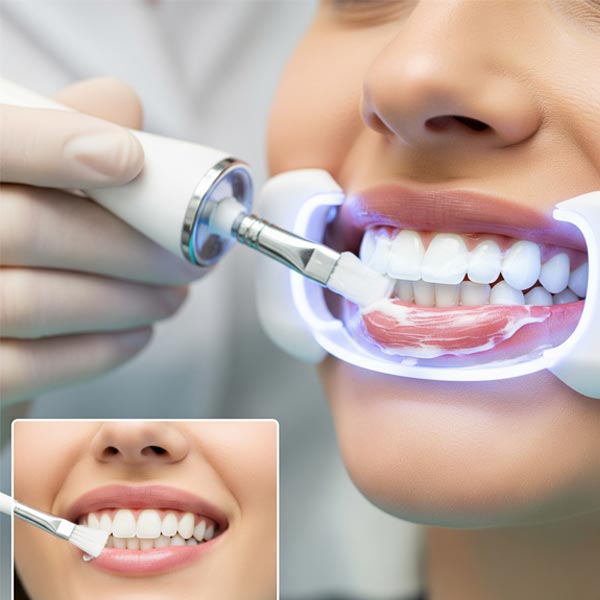Teeth Whitening Treatment
Teeth whitening treatment is a dental procedure that helps transform discolored or stained teeth into stunning white, bright teeth by utilizing teeth whitening technology, the LED Light System, and high-quality bleaching products to stimulate the disintegration of the whitening gel, which help turn discolored teeth into white, bright, and natural-looking teeth.
What causes teeth to turn yellow, black, or discolored?
1. Extrinsic staining
Foods and beverages contain chemicals, such as pre-chromogens, chromogens, or tannin, such as tea, coffee, red wine, soft drinks. These will attack the teeth and bind to the white tooth enamel, causing discoloration.
Tar or nicotine in cigarettes: Smoking is a primary cause of yellow teeth, black teeth, or dark teeth
2. Intrinsic discoloration
Aging: Our tooth enamel naturally thins with aging, allowing pigment from food and beverages to become more easily embedded in the enamel. As a result, the teeth turn yellow, brown, or darker.
Gum and tooth injuries that darken the color of the teeth: When the gums and teeth are injured, the body reacts by producing a thicker layer of dentin to protect the original dentin from destruction. However, it can also darken the color of the teeth. Certain medications, such as asthma or blood pressure medications, as well as some antibiotics used by mothers while pregnant, such as tetracycline or doxycycline.
How many types of teeth whitening treatment?
- Philips Zoom teeth whitening products (hospital- or clinic-based) are a tooth whitening procedure that uses a high-performance tooth whitening gel containing hydrogen peroxide in combination with energy wave stimulation. The outcome is dependent on the state of each individual’s teeth.
Home bleaching (Philips Zoom products), or at-home teeth whitening, is the procedure of bleaching your teeth at home using a tooth whitening kit that includes trays and teeth whitening gel. The dentist will make a mouth impression at the hospital to make teeth whitening trays and give the trays.
What is the procedure for zoom teeth whitening treatment?
- The dentist applies the cheek, tongue, lips, and gum barrier, as well as a protective gel on the gums and surrounding tissues to prevent the whitening gel from contacting the buccal and gum tissues inside the mouth and wears special blue light blocking glasses to protect eyesight while performing the teeth whitening procedure.
- The dentist will use a blow-dry tool to dry the teeth, then apply the teeth whitening gel to bleach the teeth.
The dentist uses the Zoom device’s White Speed blue LED light to stimulate the gel polish to dissolve and penetrate through the enamel layer to remove stains and turn the yellow, brown, or dull black dentin into a whiter shade of teeth.
The dentist will coat the teeth-whitening gel and repeat the light for 3–4 rounds, each session spaced approximately 15 minutes apart.
When the teeth-whitening process is complete, the dentist will suck out the whitening gel and wipe to clean the teeth, gums, tongue, and mouth area. Then, assess the outcome by comparing the teeth colors before and after teeth whitening to discern the improvement in whiter, brighter teeth.
What is the Home Bleaching and Teeth Whitening procedure?
- The dentist will take an impression of the mouth for making trays for home teeth whitening.
- After receiving the teeth whitening tray, the dentist will fit it to the teeth and gums to check if they all fit snugly.
- Teeth whitening or self-whitening at home involves squeezing the right number of teeth whitening gel as specified by the dentist onto the teeth whitening tray. Then, apply the whitening tray over the teeth and leave for 30 minutes (depending on the whitening gel concentration).
What is the aftercare for Zoom Whitening Treatment?
- The dentist will advise refraining from smoking for at least a week after treatment and avoiding foods and beverages that can cause tooth discoloration, such as tea, coffee, red wine, soft drinks, deep-colored fruit juices, and sour foods high in acid, and may prescribe painkillers.
- The dentist recommends regular oral care, including gum and tooth cleaning, with twice-a-day brushing and flossing to reduce plaque buildup and maintain a pearly white smile for a long time.
What is the disadvantage and advantage of teeth whitening?
- Teeth whitening can cause tooth sensitivity or irritation of the gum tissue, but the symptoms will only last for approximately a few days and then resolve.
- Teeth whitening treatment does not change the color of other dental materials, including fillings, dentures, crowns, and veneers, to be as white as other natural teeth surface after the treatment or bleaching.
Who is not suitable for teeth whitening?
- For those with ongoing dental issues, e.g., gum disease, tooth decay, root canal inflammation, or periodontitis.
- under 16 years of age, due to the developing nerve to the tooth, can have tooth sensitivity.
- Pregnant or breastfeeding mothers.
How long do the whitened teeth last?
After completing teeth whitening treatment, the whiteness of the teeth will last from six months to one year, depending on daily oral hygiene practices.



